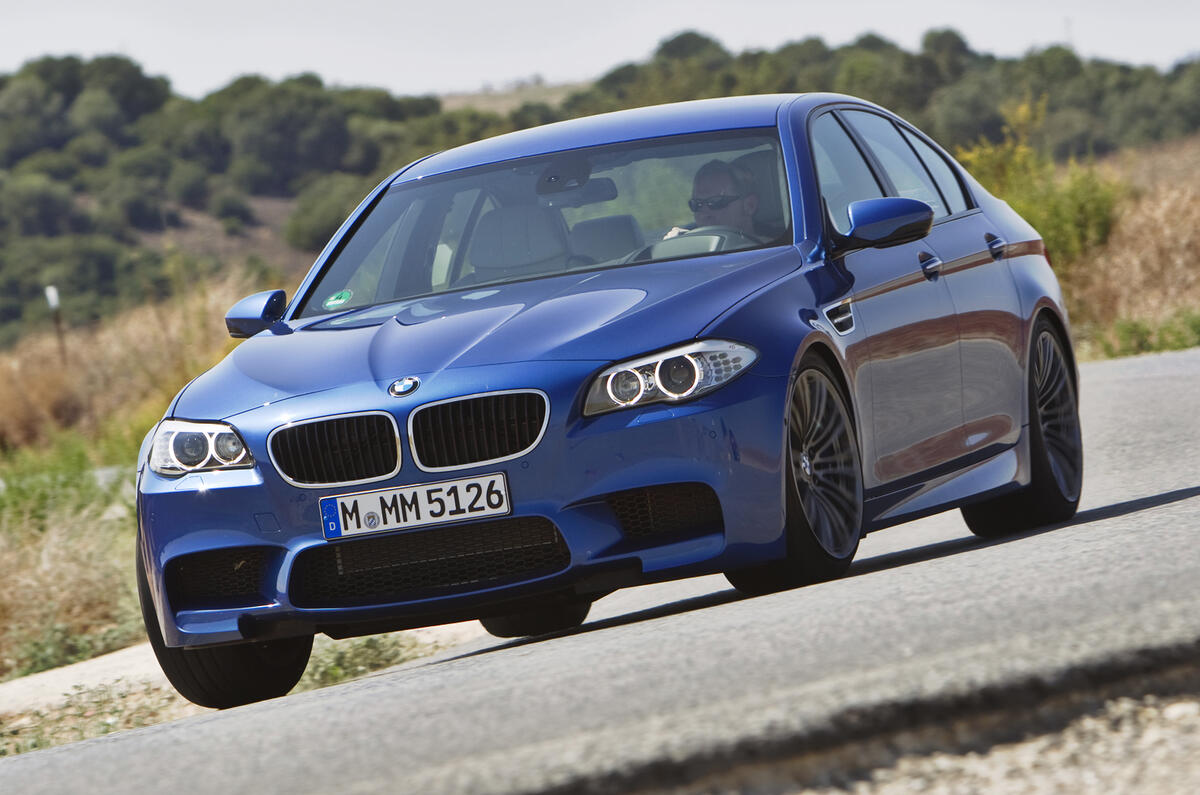BMW M5 V8 saloon first drive
BMW M5 Competition review: 616bhp super-saloon driven (2018-2019)
Car specifications
COMPARE CAR FINANCE
Mostly it competes against the Mercedes-AMG E63 S. Both are colossally powerful V8 turbo saloons with mostly four-wheel drive but a RWD mode for when you just don’t like your rear tyres any more.
Anyway, despite the name, it isn’t really for competition as in motorsport. Too heavy and complicated.
But why did they choose the name?
Well, Competition versions of the BMW M cars are like the standard single-digit vehicles, but with a bit more of an edge to them. You’ll have recently seen our piece on the ruddy brilliant M2 Competition. That car entirely replaces the regular M2. Whereas the M5 Competition sits above the regular M5, which continues on sale.
In simple numbers, it’s like this:
Power: 616bhp versus the M5’s 592bhp
Torque: stays the same at 553lb ft
0-125mph: 10.8sec versus 11.2sec
Price: £96,205 versus £89,705
M makes some of the world’s best engines. What magic did they work here?
Not a lot actually. The engine is actually the same as before, but chipped. “We knew when we developed the original engine that the rivals would soon be at this power so we protected for it,” an engineer tells Top Gear.
But it does now have a petrol particulate filter to clean the exhaust further. It’s also got sports pipes and silencer, so you hear a slightly more military noise.
And bigger grilles at the front of the car make sure it can get enough cooling air in any foreseeable circumstance.
OK, what else then, before I click away?
It’s worth staying, honest. There are subtle but notable changes to the chassis. The height is lowered by 7mm, and so it’s stuffer-sprung. Dampers are firmer, and there’s slightly different suspension geometry all-round, with different toe and camber settings and a stiffer rear anti-roll bar. Also, the engine is mounted more rigidly, which should sharpen the chassis responses by inhibiting that mass from moving around in the car.
Sounds like it should be more hardcore?
It’s a monster on the road. It’s big, mind, so it needs space to operate, and it’s heavy so it doesn’t like tight turns. But once it hits its stride it’s amazing, with huge grip, vast reserves of traction and torque to haul it out of bends, and some sense it’s involving you in things. Not a lot, but some.
And yes, that V8 really is mighty. The eight-speed autobox covers for lag, and it does sing as it works its way through the revs, surging to its 7,200rpm red-line with even more venom thanks to the new chip and pipe. Not the thunder of an AMG engine, but engaging and a bit more sociably stealthy.
BMW M5
Our Verdict
BMW M5 2011-2016
The BMW M5 is crushingly capable, but some of the charm of old M5s is gone
First Drive
BMW M5 Competition Pack first drive review
First Drive
BMW M5 Competition Package first drive review

What is it?
The fifth-generation BMW M5 – the first of its breed to eschew a highly strung naturally aspirated engine for a torque led turbocharged powerplant. A big change in philosophy from BMW’s M division, then.
Due to go on sale in the UK in November, the new BMW M5 shares just 20 per cent of its components with the standard 5-series.
Its new twin-turbo 4.4-litre V8 is a development of the unit found in the X6M. However, there are sufficient differences between the two units to lead BMW M officials to describe the M5’s engine as being new. The pair use the same block and crank, but the induction, cylinder head, internal architecture and exhaust system are unique. It’s not the truck engine many suspected, then…
The new engine delivers 51bhp more than the old naturally aspirated V10 engine at 552bhp. However, the power is now delivered 1750rpm lower in the rev range at 6000rpm. More telling, though, is the torque. It peaks a substantial 153lb ft higher than before at 501lb ft but can be tapped some 4600rpm earlier at 1500rpm – or just 700rpm beyond the engine’s nominal idle.
A further technical highlight of the new M5 is the adoption of a new seven-speed double clutch gearbox as standard. Essentially the same unit used in the M3, the Getrag engineered unit replaces the seven-speed sequential manual of the old model.
Find an Autocar car review
Driven this week



What’s it like?
In a word, rapid. It might weigh 1870kg, but in real world terms the M5 is considerably faster than the car it replaces by dint of its more accessible performance. BMW claims 0-62mph in 4.4sec – bettering the old model by 0.3sec up the strip. But I, for one, won’t be surprised to see independent tests better this figure by a considerable margin.
So it is fast – fast enough to be a real threat to your licence, so addictive is its performance and the deep thrum of its engine under full load. But what really distinguishes the new M5 from each and every M5 that has gone before it is the enormous flexibility of its power delivery. Bury the throttle at anything beyond 1500rpm – the point where peak torque is developed, and it surges forward with immense force, seemingly in any gear.
Its performance, molded in no uncertain terms by its new engine’s mountain of torque, is omnipresent. Overtaking is truly effortless, helped in no uncertain part by the effectiveness of the new seven-speed box. I’m not sure how BMW has done it, but the shifts are race car quick, accompanied on full throttle up-shifts by an alluring bark of exhaust and a hearty blip on downshifts.
Still, the added flexibility, while making the new M5 a more welcome every day proposition, does have its drawbacks. Chief among these is a curious lack of crescendo in its delivery. Because the torque is developed across such a wide range of revs, the engine doesn’t feel much stronger at 6000rpm – the point where peak power arrives, than it does down low. The shove is colossal, but it is also oddly constant.
The aluminium intensive chassis, with its new double wishbone front suspension and heavily modified multi-link rear end, offers superb body control. There is a moderate degree of lean as you guide the M5 into corners but it actions are wonderfully progressive thanks to terrific damping that ensures any movement is retained within a tightly dictated range.
There’s also an impressive level of suppleness thanks to inclusion of variable damping that serves up three levels of stiffness – comfort, sport and sport plus. Despite the obvious lack of compliancy in the standard 265/40 ZR19 front and 295/35 ZR19 tyres, the overall ride quality is outstanding.
Even in the most extreme sport plus mode, the new underpinnings manage to retain a good deal of composure, seldom allowing anything more than a sharp ripple to upset progress. In this respect, it’s much calmer and more relaxed as speeds increase than its predecessor.
It’s the steering that slightly disappoints. The speed sensitive hydraulic steering is an improvement on the electro-mechanical arrangement used by standard 5-series models, offering a more convincing feel and greater levels of feeback. But it possesses a lifeless feel around the straight ahead. It’s a pity because, once you’ve negotiated this though, it is much more alert.
Should I buy one?
Yes. We don’t care how, just make sure you do sample the new M5 in one way or the other. It is in many respects a landmark car – one that’s going to have the fast car competition – Audi, Cadillac, Jaguar, Mercedes-Benz and Maserati among them – scratching their heads as they attempt to come up with a reply.
The sheer potency and accessibility of the new turbocharged engine alleviates any lingering doubts about BMW’s M division’s decision to turn a 25-year tradition of naturally aspirated engines on its head. The question that really needs to be asked is: why did it take so long?
2012 BMW M5 first drive
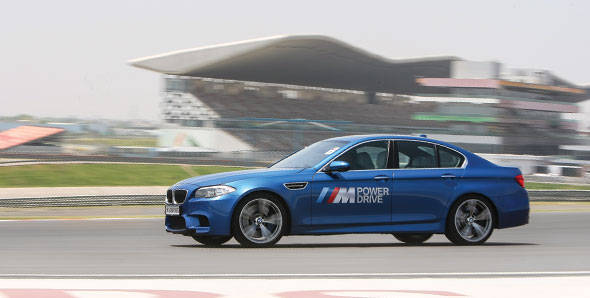
Everyone has a favourite colour. I’ve associated myself to blue ever since I was a kid. It all started in school when I somehow ended up being part of the blue house. It’s the colour that defined me over the years. T-shirts, watches or even sunglasses, it had to be blue. It’s not just you or me; many auto manufacturers too tend to favour a particular hue. A Ferrari is respected in red and a Kawasaki in green. There are no two ways about it. That’s one part of the story.
Now to the second part. I steer towards the ideal entry point on turn 3 of the Buddh International Circuit. It’s a blind corner. The steering is precise and the sharp right hander is taken spot on. Half throttle till the wheels point straight and it’s the 1.06km back straight in my view. The second longest straight in the Formula one calendar begs me to unleash the car’s raw power. Pedal to the metal then and I’m instantly pushed hard against the seat. The acceleration is mental and literally gives me goose bumps. After all, the car claims to reach the hundred mark in just 4.4 seconds. The double-clutch gearbox offers seamless shifts all the way up at 7200rpm. 200kmph is reached effortlessly with more than 400 metres left on the straight. I quickly look at the speedometer before stepping on the brakes and it reads 230kmph, some more road and the car could have eventually hit the 250kmph mark.
Braking hard for the first corner and you’re held on tight by the seatbelt under massive g-forces. Huge 400mm high performance brakes that are larger than a Gujarati thali plate ensure the car stops in no time. The front end displays excellent front-end grip and no understeer. The next few turns, especially the left into right and right into left corners, I can feel my brain swell as I fight the sideway forces. The tyres are sticky and offer excellent grip and extract the most out of the 560PS machine. Since the car is putting out all its power via its rear wheels, it loves to swing its tail wide and one requires a quick helping of opposite lock to keep the car pointing towards the desired direction. Back on the throttle on the main straight this time and the gear shifts and the exhaust note continue to arouse you. Before you know it, you’re on the back straight again. It’s time then to go repeat the process through every turn and get into serious track mode.
After what I just said, you may think that I was driving a sports car. Yes you’re right, 10 points for that. But it’s a sports car in the guise of the very same car that chauffeured me from the hotel to the race track. It’s the all-new BMW M5, the super saloon that’s based on the sixth generation BMW 5 Series. The 5 saloon was launched last year and it was obvious that the new M5 would follow soon.
The engine is the heart of any car but in an M car, it transforms a road going BMW saloon into an angry sports car just like Bruce Banner turning into Hulk. This transformation has been happening since 1984 when the first M5 was introduced. The car went on to create a new super saloon genre by slotting in an engine from the M1 supercar into a 5 Series, this made it the fastest production four-door in the world. Subsequent generations of the M5 also had very powerful engines but the configuration kept changing. The earlier models were equipped with straight-sixes, a rev happy V8 and in the previous version an even higher revving V10. The current car moves back to a V8 by borrowing the engine from the X5M and X6M SUV making this is the first ever turbocharged M5.The 4.4-litre twin-turbo engine produces a maximum power of 560PS at 6000-7000rpm while a whopping 680Nm of torque is all yours from as low as 1500 up to 5750rpm. This is the most powerful M5 ever period. BMW’s TwinPower Turbo technology has also meant that the fuel economy has improved by 30 per cent over its predecessor. A claimed figure of 10.1kmpl and an 80-litre fuel tank means one can comfortably travel long distances.
So, the M5 is a proper sports car judging by its performance and handling. A super saloon however offers something a sports car can’t dream of – space for four adults and their luggage. Step inside the M5 and one is greeted by exactly the same cabin as the 5 Series saloon. So an enormous boot, comfortable rear seats and cleverly placed cubby holes make the M5 a practical car too. All Ms are two cars in one but this M5 takes it to a whole new level. The steering feel, suspension setting and throttle response can all be independently adjusted and are offered in three modes comfort, sport and sport plus. I preferred everything set to sport mode on the track but if one prefers something different, you can save a customised setting and have it selected anytime by just pushing the M button on the steering wheel. Since there are two M buttons, you can have two completely different programs saved. One program could be for the track and the other for regular road use. Clever.
The 5 Series has always been sportier than its competition, the M division however have added subtle changes to make the M5 a sportscar with four doors. The front bumper features three large air ducts that not only look like it’s from a race car but also helps in feeding a lot of air to the radiator. Viewed from the side, the front fender gets a typical side vent with M badging but the new M5 also gets an LED indicator that splits the vent. The car we drove came with optional five-spoke 20-inch wheels that look they’ve come straight out of a supercar. One look at the rear and you know the M5 is a seriously fast car, the trademark quad exhausts and diffuser are responsible for this. The small rear spoiler goes unnoticed at times. With the practicality of a four door and the performance of a sports car, the M5 is the perfect recipe of the ideal car.
Now back to the first part of my story. My obsession with the colour meant that the cars and bikes I owned were all blue. There was a particular shade of metallic blue that I insisted on being sprayed on all my vehicles (including dad’s cars). It even has its own name, ‘Halley Blue’, in a small paint shop in Bangalore.
Taming the M5 around the BIC was an unforgettable experience but it all started when I saw the car that was assigned to me. It was metallic blue. This is the first time that the M5 is available in my favourite colour. BMW call it ‘Monaco Blue’ but for me it’s still ‘Halley Blue’.
Bmw M5 Saloon
Want this car at a great price?
Review of the BMW M5 Saloon
The new BMW M5 Saloon is the fastest, baddest version of the wonderful 5 Series Saloon. It’s a high performance, super-saloon car that bosses the tarmac with its 4.4-litre V8 engine.
Four-wheel-drive is standard but the car retains BMW’s classic rear-wheel-drive feel, and it works well as a motorway cruiser and a winding road speedster. All you need to be prepared for is to have some fun.
BMW started as a company making aircraft engines during World War I. Find out how they went from the air to the road and became one of the most popular cars on UK roads in our brief history of BMW.
OSV takes a closer look at what it’s all about with our 2018 BMW M5 Saloon review.
Overview of the BMW M5 Saloon
On the Road
A twin-turbo 4.4-litre V8 petrol engine provides the power, developing 592bhp. That’s enough to allow you to cover the 0-62 sprint in just 3.4 seconds, which makes it one of the fastest cars in this sector.
It’s impossible for us to do justice to the way this car sounds here, but let’s just ask you this: Have you ever heard a car scream? If you haven’t, you’re in for a shock. The M5 howls like an actual demon, and it’s a fizzing sound that some will love while others will hate.
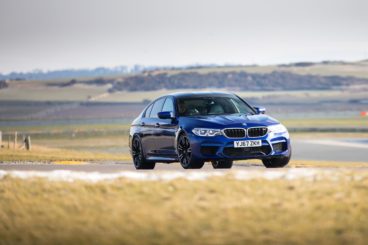
The way the car feels will divide opinion, too – it feels like a racing car. While some of you will be salivating at that prospect, others will be left wondering why a saloon car – no matter how “super” it is – feels that way.
It was BMW’s prerogative to make a fearsome version of their 5 Series, and they’ve really pulled it off. However, the M5 is just the start of things. Next up is an M5 Competition model that raises even more hell. It develops an avalanche of power, topping you up to 616bhp and decreasing its 0-62 time down to 3.3 seconds. We’re edging closer to the speed of light here!
That said, where the Competition model differs from the standard model isn’t really in the area of straight line speed. Instead, BMW have tweaked its suspension setup so that performance is significantly better. It’s more responsive and more accurate. It will also cost you an extra £6,500.
Both models come with four-wheel drive as standard, but the system doesn’t make the car too heavy handed. It arms you with lots of grip but, ultimately, it almost feels like any other rear-wheel-drive BMW.
Ceramic brakes, meanwhile, are optional and will set you back a further £7,500.
BMW M5 Saloon Interior, Design and Build
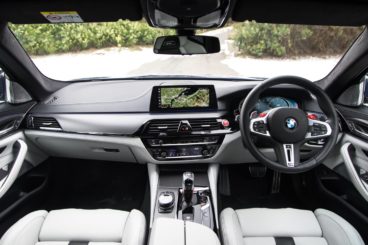
The M5 might be a high-performance car, but it’s also a Saloon, and as such it has a few obligations. One of them is to make sure you’re as comfortable as possible, and it succeeds very well on this front. The supportive sports seats up front offer plenty of comfort and switching to Comfort mode primes the car so that it smooths over poorer surfaces.
The dashboard is neatly laid out, and everything is easy to find and use. As always, the brand’s newest version of their iDrive infotainment system is present and correct, and it now comes with a 10.25” screen.
Also standard is a touch-sensitive rotary controller, as well as digital dials that bring the car into 2018 nicely.
Is the BMW M5 Saloon practical? The seats are pretty chunky, but they don’t take up too much room. That said, those seated up front have more space than those in the back, although rear seated passengers won’t feel too short-changed. Longer trips could be a bit testing back there though.
Storage solutions are good and include a satisfyingly-sized glovebox, while the boot measures 530-litres. This is all the more impressive when you consider that four-wheel-drive is standard.
How reliable are BMW? We’ve looked into reports of BMW reliability and have written our own honest assessment of the brand.
Equipment and Safety of the BMW M5 Saloon
Standard kit is good, with the M5 model getting leather upholstery for the heated powered sports seats, all-round parking sensors, a head-up display, a digital radio, sat-nav, digital dials, iDrive, adaptive LED lights with high beam assist and four-zone climate control.
The M5 Competition model adds suspension tweaks, more power, more gloss black trim and 20” alloys.
Optional for both models are ceramic brakes and a £1,100 sports exhaust.
In terms of how safe the car is, the standard 5 Series Saloon has a 5-star safety rating, but this high-performance version won’t be tested. Its standard safety kit includes adaptive cruise control, rear cross-traffic alert, lane departure warning and an excellent autonomous emergency braking system.
Costs of the BMW M5 Saloon
Prices for the new car start at £89,645. For more information on our leasing deals, you can check out our page here.
In terms of its running costs, the sole petrol engine wasn’t designed to be economical. On a good day, the standard model can return 26.9mpg, while the Competition model is good for 26.1mpg at best.
Emissions meanwhile are pegged at 245g/km of CO2, and the car has the highest BiK rating possible. All M5’s cost £140 a year to tax, but because they also cost over £40,000 to buy in the first place, you’ll also be liable to pay a surcharge of £310. That takes your annual bill up to £450. Not cheap then, and the M5 also occupies the highest insurance group possible.
Pros and Cons of the BMW M5 Saloon
A bulging 4.4-litre V8 engine growls beneath the bonnet and arms the car with a salivating 592bhp.
Despite the staggering performance figures, this is still a saloon car. To that end, it’s super comfortable.
The standard 5 Series model has a 5-star safety rating, while the M5 comes with powerful brakes and a long list of standard safety kit to reassure you.
Not as engaging as last time
It’s probably a sign of the times, but while the M5 works undoubtedly as well as a high-speed cruiser, it’s definitely lost an edge.
Its price tag means a lot of buyers will be seriously questioning its worth over cheaper rivals, and indeed the standard 5 Series.
BMW M5 Saloon vs Mercedes E63 vs Lexus GSF
Let’s see how the car fares against its rivals in the comparison section of our 2018 BMW M5 Saloon review.
BMW M5 Saloon vs Mercedes E63
The new Mercedes E63 is the AMG, high-performance version of their E Class exec saloon.
On the road, Mercedes are well-known for prioritising comfort over entertainment, but the E63 delivers a first-class driving experience. Power comes from a twin-turbocharged 4.0-litre V8 engine that develops 563bhp.
Four-wheel-drive is standard, the car handles phenomenally, and it isn’t as intimidating to drive as it looks or sounds.
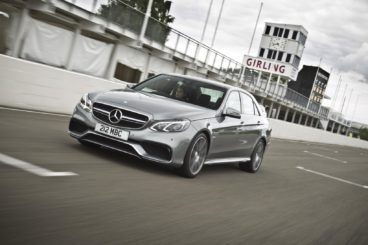
It’s noisy too, with the engine spitting furiously as you put your foot down. And thanks to air suspension, it’s pretty much as comfortable as you expect a Mercedes to be. That said, you can flick between driving settings so that the car is either more comfortable or more fun.
The steering, meanwhile, is precise and sharp, and body lean is well kept in check.
There’s also an S model worth mentioning. This is one of the fastest and most advanced super saloons on the road, and it has a 0-62 time of 3.4 seconds… Hair-raising stuff.
Running costs? In standard guise, the E63 can manage 31mpg if you drive like a monk, while emissions are pegged at 208g/km of CO2. It sits in the highest BiK car tax band there is.
Inside, it’s business as you usual for Mercedes. There’s luxury everywhere you look, from the carbon fibre trim to the Nappa leather. The performance seats are both supportive and comfortable, insulation is excellent and the adjustable suspension ensures that it’s a pleasant place to spend your time.
It’s a bit of a shame that only the S model gets the twin-monitor widescreen multifunction display as standard, however.
Is the Mercedes E63 Saloon practical? It’s a big saloon that’s spacious enough to accommodate four passengers on longer trips without much hassle. Leg and headroom is excellent all-round and the boot – which is a good shape – measures a very handy 540-litres.
BMW – £89,645
Mercedes – £80,000 – £89,920
BMW M5 Saloon vs Lexus GSF
The new Lexus GSF is the alternative choice in this sector, and its lack of badge appeal is usually what means it ultimately loses out to its rivals.
That said, it isn’t just the fact that it’s not a BMW which means it doesn’t sell as well as the M5. With a 0-62 time of 4.5 seconds, it’s over a second slower than its competitor. It’s also not quite as powerful and develops 466bhp at the most.
Moreover, unlike both the BMW and the Mercedes, there’s only one model available, which means there are no ridiculous 0-62 times of 3.3 seconds.
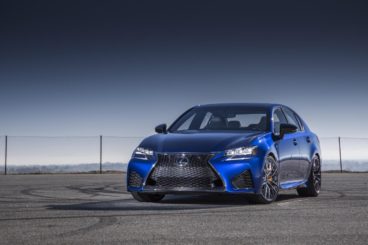
Despite this, we wouldn’t write the GSF off just yet. It’s powered by a terrific, spine-tingling V8 petrol engine, corners superbly, and comes with a dynamic drive system that lets you switch between four different driving settings.
We prefer Normal mode the best, as it blends sharpness with comfort to great effect.
All models come with adjustable adaptive variable suspension, while the sound of the engine is a joy to behold.
Overall though, it can’t quite match the M5 for handling finesse, and you’re always aware of its weight. Moreover, a dated automatic gearbox further weakens its appeal.
Running costs? These large 5.0-litre V8 engines are never cheap to run, but with a 0-62 time so much slower than the BMW you’d be forgiven for expecting better returns than 25.2mpg. That’s just the official figure too, and it’s likely that you’ll be averaging 19mpg.
Emissions meanwhile stand at 260g/km of CO2.
Inside, this car might lack the out and out badge appeal of the M5, but no one can say that this isn’t a top-notch interior. It’s stylish and luxurious without being class-leading, and when it comes to comfort there are few cars on the market that can beat it.
The materials used are all of a good quality, and we think buyers will especially appreciate the sporty trim inserts and suede-effect Alcantara. There’s also lots of soft leather on display here, although it’s a bit of a shame that the likes of a classy Mark Levinson stereo and a sunroof aren’t standard.
Is the Lexus GSF Saloon practical? It’s certainly roomy, with both those upfront and those in the rear well-accommodated. Head and legroom is good and the car doesn’t really feel any less usable than the standard saloon on which it’s based.
Its boot is even quite large and measures 480-litres when all five seats are up.
Verdict of our 2018 BMW M5 Saloon Review
Let’s face it, basing a car on the magnificent BMW 5 Series means that BMW couldn’t go wrong with this one. It’s a super saloon that just had to build on everything that makes the 5 Series so good.
That it does, but the problem is that it doesn’t necessarily build on everything that made the previous M5 so good.
Don’t get us wrong – this is still a very, very special car that deserves a 5/5 rating. But it’s not as engaging as its predecessor, and it also doesn’t sound as good. If these are the two attributes that make a saloon super to you, you might be in two minds.
That said, no car can hold a candle to the previous M5 – and this new BMW M5 Saloon is as close as you’ll get.

When you lease a car with OSV there are no hidden costs, request a call back and we’ll find you a finance, lease or purchasing deal designed just for you.



